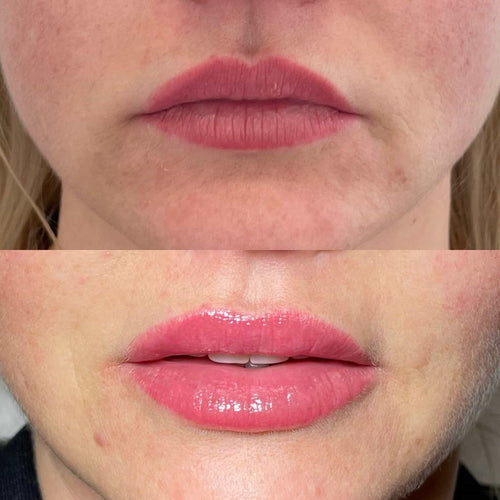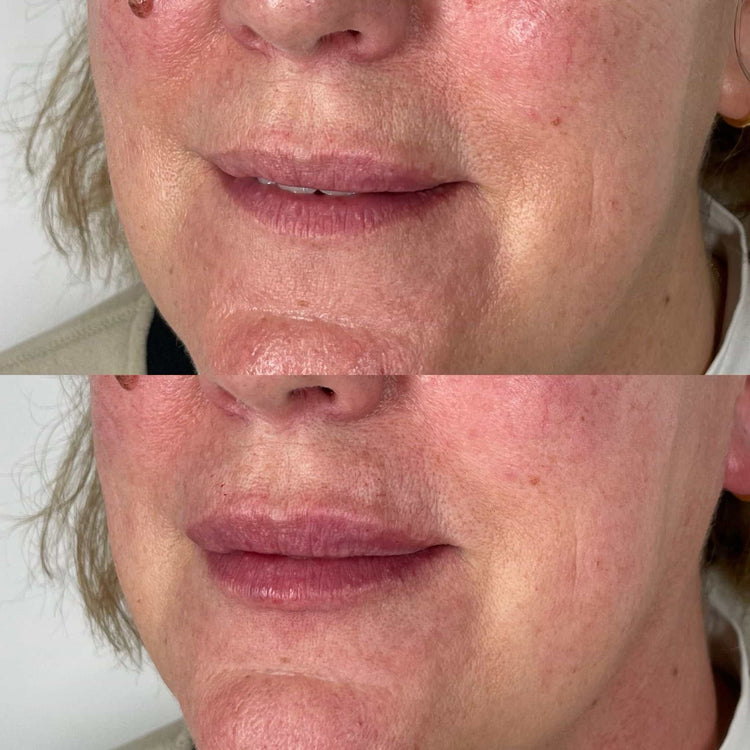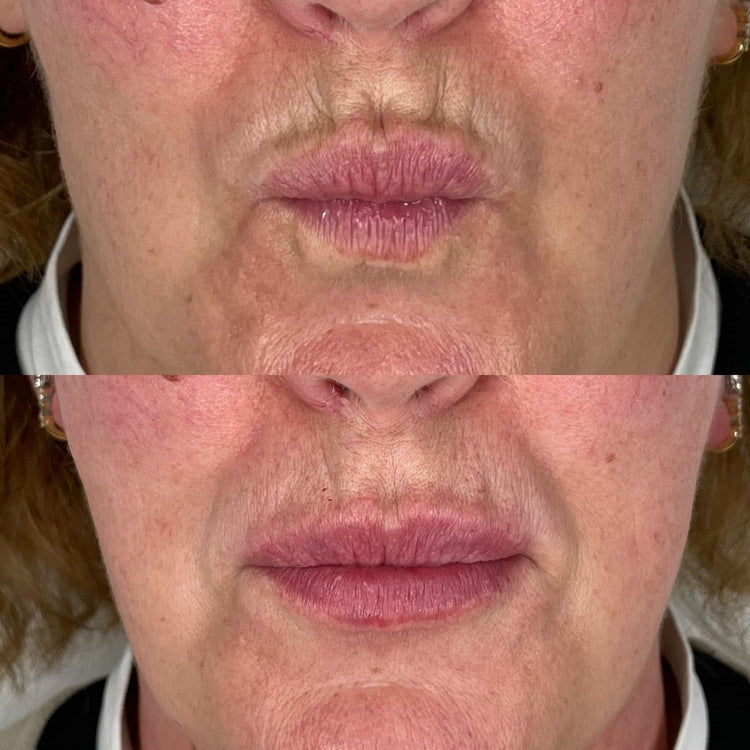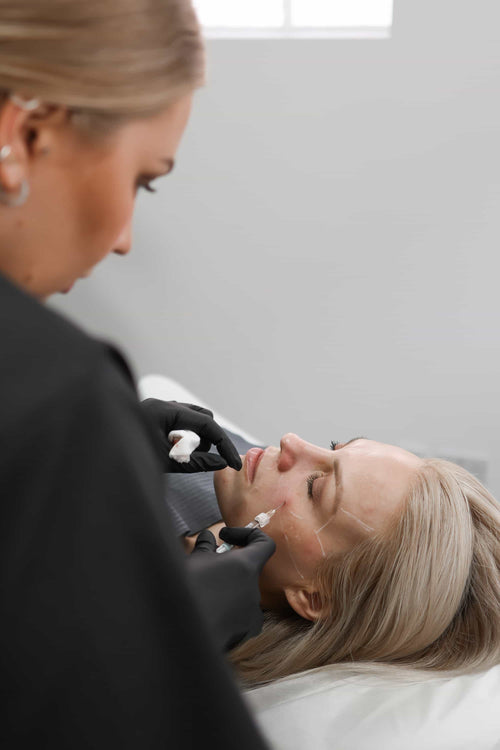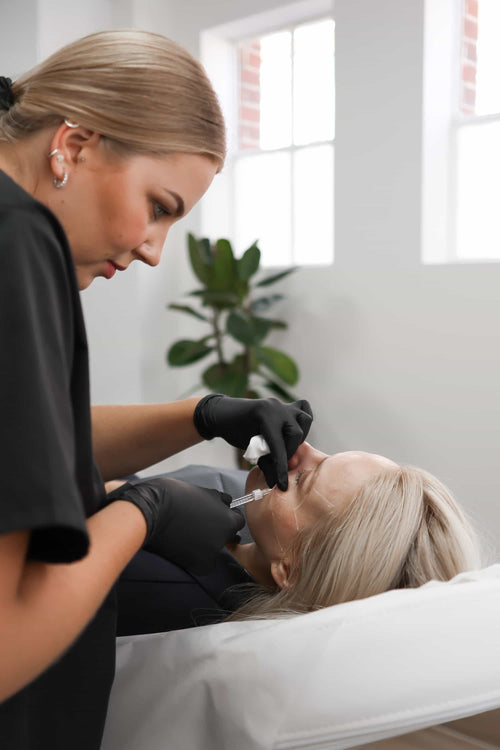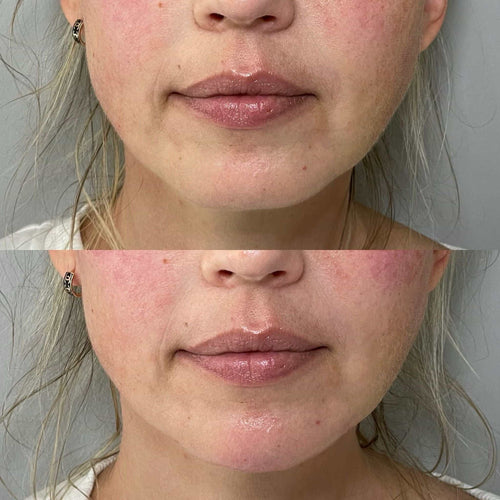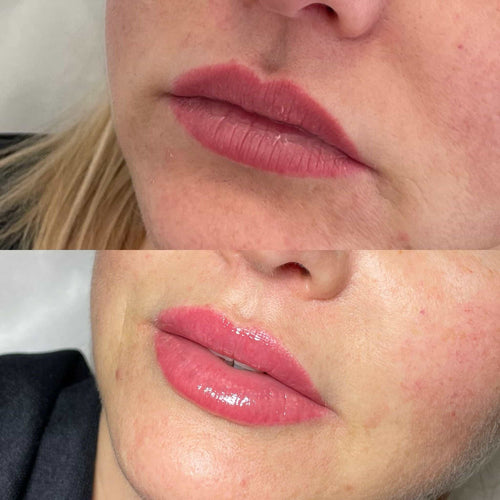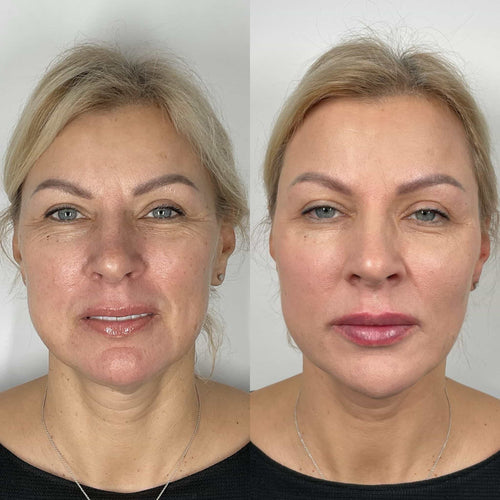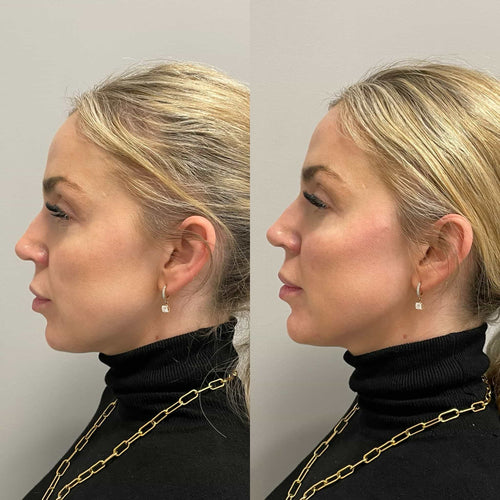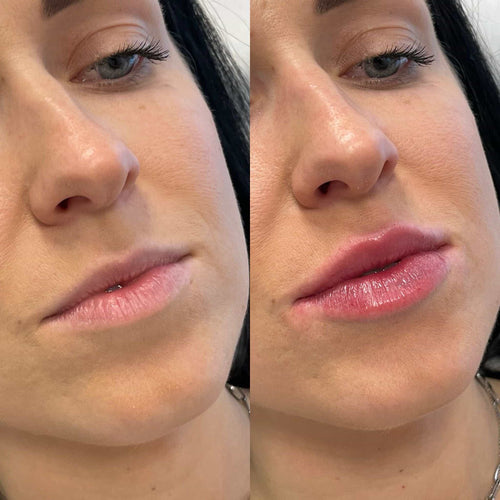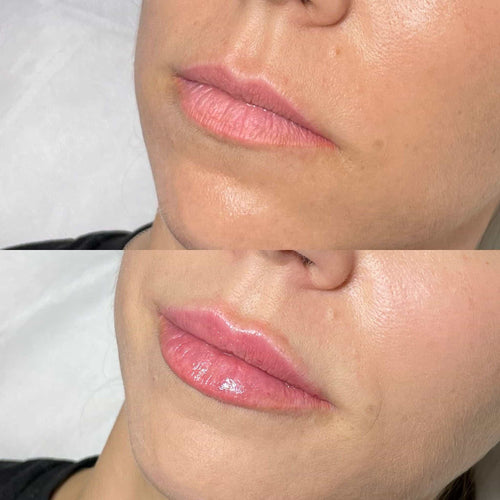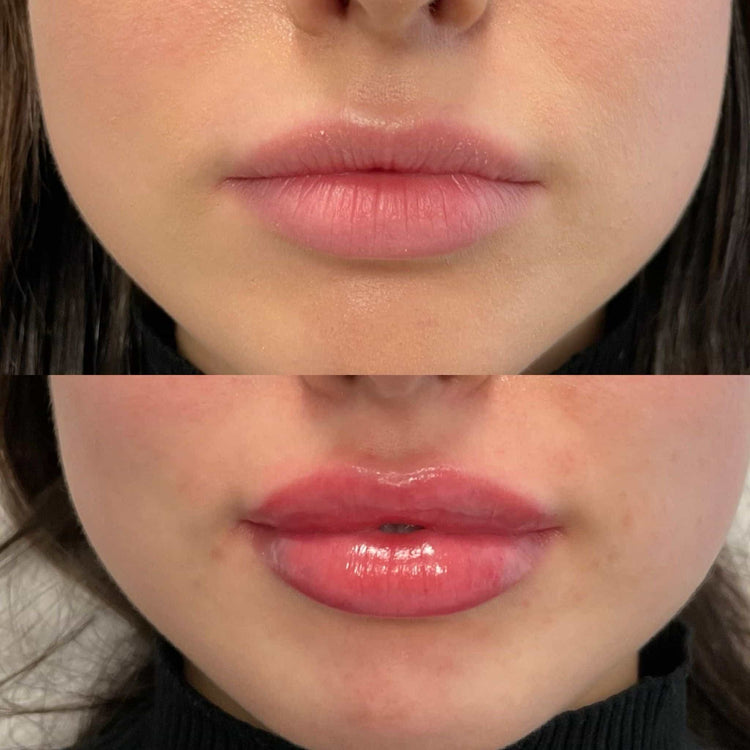Book a Consultation for Dermal Fillers with Dr. Laura Geige Today
Understanding Lip Filler Bruising
Lip filler bruising, also known as hematoma or ecchymosis, is a common side effect that can occur after lip filler injections. It’s essential to understand the causes and factors that contribute to this temporary condition, so you can take steps to minimize its appearance and promote healing.
The most common cause of lip filler bruising is bleeding under the skin after the injection. When the filler material is inserted into the lip tissue, it can cause tiny blood vessels to break open, leading to a collection of blood beneath the surface of the skin. This blood accumulation can lead to swelling, pain, and discoloration around the treated area.
Several factors can increase your risk of developing bruising after lip filler injections:
-
Using a foreign body, such as a needle or cannula, to inject the filler material can cause irritation and inflammation, leading to bleeding and bruising.
-
Having low blood platelet count (thrombocytopenia) or high blood pressure can impair blood clotting and increase the risk of bruising.
-
Poor circulation or vascular health can reduce blood flow to the treated area, leading to prolonged bleeding and increased risk of bruising.
-
Using a filler material that is too large or of poor quality can cause an inflammatory response, leading to swelling and bruising.
Other causes of lip filler bruising include:
-
Overfilling or using excessive amounts of filler material, which can lead to irritation and inflammation.
-
Poor aftercare techniques, such as not applying adequate pressure to the treated area or not keeping the head elevated for a sufficient amount of time.
In some cases, lip filler bruising can be caused by allergic reactions to the filler material. If you experience any unusual symptoms, such as redness, swelling, itching, or difficulty breathing after your treatment, seek medical attention immediately.
Fortunately, most cases of lip filler bruising are mild and resolve on their own within a few days. However, more severe cases can lead to prolonged swelling and discoloration that may take several weeks to heal.
It’s essential to follow your provider’s instructions for aftercare to minimize the risk of complications and promote optimal healing. This typically includes:
-
Applying ice packs or cold compresses to reduce inflammation and swelling.
-
Avoiding strenuous activities, such as exercise or heavy lifting, for a few days after treatment.
-
Keeping the head elevated for at least several hours after treatment to reduce blood pooling in the face.
Additionally, some products and home remedies can help promote healing and reduce the appearance of bruising:
-
Cold compresses or ice packs: These can help reduce swelling and inflammation by constricting blood vessels.
-
Aloe vera gel: Applying aloe vera gel to the affected area may help reduce inflammation and promote healing.
-
Arnica oil: Topical application of arnica oil has been shown to reduce swelling and bruising in some studies.
In severe cases, your provider may need to perform additional treatments or procedures to resolve lip filler bruising. These may include:
-
Aspirin therapy: In rare instances, aspirin may be prescribed to help dissolve blood clots and promote healing.
-
Ultrasound treatment: This non-invasive procedure can help break up blood clots and reduce swelling.
In conclusion, lip filler bruising is a common side effect that can occur after lip filler injections. By understanding the causes and factors that contribute to this condition, you can take steps to minimize its appearance and promote healing. Following your provider’s instructions for aftercare and using certain products or home remedies may also help reduce the severity of lip filler bruising.
Lip filler bruising, also known as **sialosis** or perioral hematoma, is a common side effect of lip augmentation procedures using dermal fillers. It’s characterized by the appearance of a blue or purple discoloration around the mouth, which can be unsightly and embarrassing.
The bruising occurs when blood vessels are damaged during the injection process, causing bleeding under the skin. The severity of the bruising depends on several factors, including the type of filler used, the location and depth of the injection, and individual healing characteristics.
**Causes of Lip Filler Bruising:**
* Damaged blood vessels
* Insufficient or excessive filler material
* Poor needle technique
* Inadequate post-procedure care
The most common lip fillers associated with bruising are:
1. **Hyaluronic acid** (e.g., Juvederm, Restylane)
2. **Calcium hydroxylapatite** (e.g., Radiesse)
3. **Polylactic acid** (e.g., Sculptra)
The appearance of lip filler bruising can vary in severity and duration. Mild cases may resolve within a few days, while more severe cases can take weeks or even months to fade.
Some common signs and symptoms of lip filler bruising include:
• Discoloration around the mouth
• Purple or blue discoloration
• Swelling or inflammation
• Numbness or tingling
Treating Lip Filler Bruising:
To minimize the appearance of lip filler bruising, it’s essential to follow proper post-procedure care. Here are some tips:
1. **Massage**: Gently massage the affected area with your fingers in a circular motion for several minutes, 2-3 times a day.
2. **Cold compresses**: Apply a cold, damp washcloth to the area to reduce swelling and promote blood clotting.
3. **Avoid strenuous activities**: Refrain from strenuous exercises or activities that can increase blood pressure, such as heavy lifting or bending.
4. **Keep the area clean**: Avoid touching or rubbing the affected area, and keep it clean with a mild soap and water.
5. **Use topical treatments**: Apply topical creams or gels containing ingredients like arnica, vitamin K, or peptides to reduce inflammation and promote healing.
It’s essential to note that lip filler bruising can be unpredictable, and even proper care may not completely resolve the issue. In some cases, surgical treatment or additional procedures may be necessary to remove excess filler material and promote complete healing.
Lip filler bruising, also known as post-inflammatory hyperpigmentation (PIH), can occur when injecting too much filler into one area of the lip.
This type of bruising is caused by inflammation in the skin, which leads to the formation of blood vessels that become damaged and swollen.
The filler, typically composed of hyaluronic acid or calcium hydroxylapatite, can cause an immune response, leading to the release of histamine and other chemicals that contribute to inflammation and bruising.
Overinjection can also cause the filler to migrate out of the desired injection site, leading to uneven distribution and increased risk of bruising.
Faster-acting fillers, such as those with preservatives, may be more likely to cause bruising due to their higher viscosity and potential for irritation.
Injecting too much filler into one area can also lead to necrosis, or cell death, which can result in the formation of a cyst or abscess.
The severity of lip filler bruising can vary depending on individual factors, such as skin type, medication use, and overall health.
Common causes of lip filler bruising include:
- Overinjection: Injecting too much filler into one area
- Inadequate technique or experience
- Using the wrong type of filler for your individual needs
- Poor skin health due to factors like smoking, sun exposure, or collagenase injections
To minimize the risk of lip filler bruising, it’s essential to choose a qualified and experienced healthcare professional for the procedure.
They should have a thorough understanding of lip anatomy, injection techniques, and filler properties to ensure safe and effective treatment.
Before undergoing lip filler treatment, it’s crucial to discuss any concerns or medical conditions with your healthcare provider, such as allergies, cold sores, or autoimmune disorders.
A good skincare routine before and after treatment can also help reduce the risk of bruising, including regular cleansing, moisturizing, and using sunscreen to protect the skin from damage.
Topical creams or gels containing ingredients like arnica, vitamin K, or peptides may also be recommended by your healthcare provider to aid in healing and reduce bruising.
In some cases, oral anti-inflammatory medications or corticosteroid injections may be prescribed to manage swelling and inflammation.
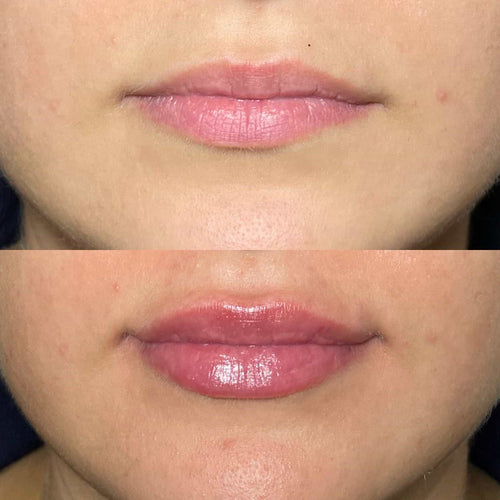
However, it’s essential to follow the instructions carefully and not overuse these treatments, as this can lead to further complications or side effects.
A thorough aftercare plan should include regular follow-up appointments with your healthcare provider to monitor healing progress and address any concerns or issues that arise.
With proper care and attention, most lip filler bruising cases resolve on their own within a few weeks.
However, in some cases, scars or discoloration may persist, especially if left untreated or if the underlying cause is not addressed.
Lip filler bruising is a common and frustrating side effect that can occur after lip fillers are administered. It’s essential to understand the causes of bruising, particularly when it comes to improper technique, to take steps in preventing or minimizing its appearance.
Book Your Dermal Filler Consultation with Dr. Laura Geige at It’s Me and You Clinic
Using the wrong injection technique or equipment can cause trauma to the skin, resulting in bruising. Here are some common mistakes that can lead to lip filler bruising:
- Incorrect Angle of Injection: Injecting at the wrong angle can cause the filler material to migrate under the skin, leading to bruising and swelling.
- Inadequate Anesthesia: Failing to use adequate anesthesia or numbing cream can cause discomfort and trauma to the skin, resulting in bruising.
- Insufficient Lidocaine: Using too little lidocaine or not using it at all can lead to inadequate anesthesia, causing bruising and discomfort.
- Inadequate Pressure Control: Applying too much pressure while injecting can cause trauma to the skin, resulting in bruising and swelling.
- Using the Wrong Equipment: Using needles that are not designed for lip fillers or syringes that are not sterilized can increase the risk of bruising.
- Lack of Sterilization: Failing to sterilize equipment and treatment areas can lead to infections, which can cause bruising.
It’s essential to note that even with proper technique and equipment, lip filler bruising can still occur. However, by avoiding these common mistakes, you can minimize the risk of bruising and ensure a smoother recovery process.
The causes of lip filler bruising can be divided into two main categories: traumatic injury and vascular obstruction. Traumatic injury occurs when the skin is damaged during the injection process, while vascular obstruction occurs when the blood vessels are blocked, preventing blood from flowing back to the surface of the skin.
Causes of Traumatic Injury
- Needle Slippage: When the needle slips or moves during the injection process, it can cause trauma to the surrounding tissue.
- Over- Injection: Injecting too much filler material at once can cause the skin to rupture, leading to bruising and swelling.
- Incorrect Placement: Placing the filler in the wrong location or with the wrong technique can lead to bruising and trauma.
Causes of Vascular Obstruction
- Lipodermatosclerosis: This condition occurs when there is inflammation of the fatty tissues under the skin, leading to blockage of the blood vessels.
- Atherosclerosis: The hardening and narrowing of the blood vessels due to plaque buildup can reduce blood flow, leading to bruising and swelling.
To minimize the risk of lip filler bruising, it’s essential to choose a qualified and experienced practitioner who uses proper technique and equipment. Regularly follow post-injection instructions and attend follow-up appointments to ensure that any bruising or swelling resolve quickly and properly.
Lip filler bruising is a common side effect that can occur after receiving lip injections, and it’s essential to understand what causes it and how to minimize its occurrence.
The primary cause of lip filler bruising is the injection of foreign substances, such as hyaluronic acid or other fillers, into the skin. When these substances are administered, they can disrupt the normal blood flow in the area, leading to bleeding and inflammation.
Additionally, some individuals may be more prone to bruising due to underlying medical conditions or medications. For example, people with platelet disorders, such as bleeding diathesis, may be at higher risk of bruising after lip filler injections. Similarly, individuals taking certain medications, such as anticoagulants or anti-inflammatory drugs, may also experience increased bruising.
Other factors can contribute to the likelihood of lip filler bruising, including:
Location of injection: Bruising is more common when fillers are injected into areas with loose skin, such as the lips, cheeks, or chin. In these areas, there may be a higher risk of bleeding due to the thinness of the skin and underlying connective tissue.
Type of filler used: Different types of fillers have varying degrees of vascular permeability, which refers to how easily blood vessels allow substances to pass through. Fillers with lower vascular permeability, such as calcium hydroxylapatite or poly-L-lactic acid, may be less likely to cause bruising than those with higher vascular permeability, like hyaluronic acid.
Individualized anatomy: The shape and size of the lips, as well as the individual’s skin thickness and structure, can also contribute to the likelihood of lip filler bruising. For instance, people with thinner skin may be more prone to bruising due to the increased transparency of the skin.
Sensitivity is a critical factor in determining how long it will take for bruising to resolve after lip filler injections. Some individuals may experience mild sensitivity or discomfort in the treated area, while others may experience significant pain, swelling, or redness that can last from a few hours to several weeks.
Mild sensitivity typically resolves within 2-4 days after injection, while moderate to severe bruising can take up to two weeks or more to fully resolve. Factors that can influence the degree of sensitivity and bruising severity include:
Method of injection: The technique used by the practitioner can impact the amount of bleeding and inflammation. A skilled injector who uses gentle, precise techniques may minimize bruising and discomfort.
Pain management during injection: Effective pain management strategies, such as topical anesthetics or numbing agents, can help reduce discomfort during the procedure and lower the risk of bruising.
Individual tolerance to filler substances: Some people may be more sensitive to certain fillers than others. For instance, hyaluronic acid may be less likely to cause significant bruising in individuals who are accustomed to using this substance for lip augmentation.
To minimize the risk of lip filler bruising and sensitivity, it’s essential to work with a qualified and experienced practitioner who uses proper technique, takes necessary precautions, and addresses any individual concerns or needs. Some additional measures that can help reduce bruising include:
Applying pressure after injection: Gently pressing on the treated area for 5-10 minutes can help constrict blood vessels and reduce bleeding.
Massaging the treated area
Avoiding strenuous activities, such as heavy exercise or bending, can also minimize bruising by reducing blood flow to the affected area.
Lip filler bruising is a common side effect of lip augmentation procedures, and it can be distressing for individuals who have invested time and money into achieving the desired pout.
The causes of lip filler bruising are multifaceted and can be attributed to various factors, including the type and amount of filler material used, the technique employed by the injector, and individual patient characteristics such as skin thickness and circulation.
When a lip filler is injected, it can cause damage to the surrounding blood vessels, leading to bleeding and inflammation. This can result in the appearance of bruising, swelling, and discoloration around the treated area.
The severity of lip filler bruising can vary widely from person to person, and it can range from mild to severe. Mild bruising may be barely noticeable, while more pronounced cases can leave lasting marks on the skin.
There are several factors that contribute to the development of lip filler bruising, including:
The type of filler material used: Different types of fillers have varying levels of risk for causing bruising. For example, hyaluronic acid-based fillers like Juvederm and Restylane are generally considered to be more bruise-prone than calcium hydroxylapatite-based fillers like Radiesse.
The amount of filler used: Overfilling or using excessive amounts of filler can increase the risk of bruising, as it puts pressure on the surrounding skin and underlying tissues.
The injection technique employed by the injector: Improperly placed or injected fillers can cause damage to the delicate blood vessels in the lip area, leading to bruising.
Individual patient characteristics: Some individuals may be more prone to bruising due to factors such as thin skin, poor circulation, or a history of bruising easily.
The best way to minimize the risk of lip filler bruising is through careful consultation and planning with a qualified and experienced injector. During the initial consultation, the injector should discuss the following:
The type of filler material recommended for your specific needs and skin concerns
The amount of filler that will be used to achieve the desired results while minimizing the risk of complications
The injection technique employed by the injector and any special precautions taken to minimize bruising
Post-treatment care instructions to promote healing, reduce inflammation, and minimize scarring
After receiving lip fillers, it’s essential to follow a comprehensive post-care plan to minimize the risk of complications and optimize outcomes. This may include:
Avoiding strenuous activities, such as exercise or heavy lifting, for several days after treatment
Applying cold compresses or ice packs to reduce inflammation and promote healing
Avoiding rubbing or massaging the treated area for a few days to prevent dislodging the filler material
Taking anti-inflammatory medications as directed by your injector or physician to reduce swelling and discomfort
Attend follow-up appointments with your injector to monitor healing progress and address any concerns
It’s also crucial to note that lip filler bruising can be treated, although the effectiveness of treatment may vary depending on the severity and location of the bruise.
Treatment options for lip filler bruising include:
Cooling or cold compresses: Applying a cool compress to the affected area can help reduce swelling and ease discomfort
Pain relief medications: Taking over-the-counter pain medications, such as ibuprofen or acetaminophen, as directed by your doctor or pharmacist may provide relief from discomfort and inflammation
Topical creams or gels: Applying topical treatments containing ingredients like arnica, vitamin K, or hyaluronic acid may help reduce swelling, promote healing, and minimize the appearance of bruising
Micro-needling or chemical peels: In some cases, micro-needling or chemical peels may be used to stimulate collagen production and improve skin texture, which can help fade the appearance of lip filler bruises over time
It’s essential to remember that lip filler bruising is usually temporary and resolves on its own within a few days to weeks. However, in some cases, it may take longer for the bruise to fully heal.
To prevent lip filler bruising from occurring in the first place, consider the following:
Choose an experienced and qualified injector who uses gentle and precise techniques
Select a reputable and licensed medical spa or clinic that follows strict sanitation and safety protocols
Follow your injector’s advice on pre- and post-treatment care to minimize the risk of complications
Avoid sharing lip fillers with others, as this can increase the risk of transmission of infection or other complications
Consider discussing your medical history, medications, and any concerns you may have with your injector before treatment to ensure a safe and effective procedure.
Minimizing Bruising with Aftercare
Maintaining proper aftercare is crucial to minimize bruising, swelling, and pain after lip filler injections.
Routine Aftercare Steps
-
Apply an ice pack or a cold compress wrapped in a cloth for the first few hours after treatment to reduce inflammation and bruising.
-
Use a gentle, fragrance-free cleanser to clean your lips with lukewarm water. Gently pat dry with a clean towel.
-
Avoid using harsh soaps or exfoliating scrubs on your lips for the first 24 hours.
-
Apply a topical anesthetic cream, such as Orajel or Anbesol, to numb the area and reduce any discomfort or pain.
Dietary Changes to Reduce Swelling
-
Avoid spicy food, citrus fruits, and acidic beverages like orange juice, tomato juice, and vinegar for the first few days after treatment.
-
Stay hydrated by drinking plenty of water to help flush out toxins and reduce swelling.
-
Consider taking a supplement like vitamin K or a natural anti-inflammatory like turmeric to promote blood clotting and reduce inflammation.
Lifestyle Adjustments
-
Avoid strenuous exercise, heavy lifting, or any activity that can increase blood flow to the treatment area for at least 24 hours after treatment.
-
Get plenty of rest and try to manage stress levels by practicing relaxation techniques like meditation or deep breathing exercises.
-
Avoid smoking, as it can constrict blood vessels and increase the risk of bruising and swelling.
Pain Management
-
Take over-the-counter pain relievers like ibuprofen (Advil or Motrin) or acetaminophen (Tylenol) as directed to manage any discomfort or pain.
-
Certain medications, such as aspirin or certain antidepressants, should be avoided for a few days after treatment as they can increase the risk of bruising and bleeding.
-
Apply topical creams or ointments containing lidocaine or benzocaine to numb the area and reduce pain.
Scheduling Follow-Up Appointments
-
Schedule a follow-up appointment with your doctor or dentist 7-10 days after treatment to check on the healing progress and remove any temporary filler.
-
Keep in mind that some swelling, redness, or bruising may persist for up to two weeks after treatment, but this should subside over time.
Maintaining a consistent aftercare routine and following these tips can help minimize bruising, swelling, and pain after lip filler injections and ensure the best possible results.
“Minimizing *bruising* after lip filler treatments is crucial to achieve the desired results and maintain confidence in one’s appearance.”
A well-planned post-procedure care routine can help reduce the severity of bruising, promote healing, and minimize downtime.
**Ice therapy** is a widely recommended method for reducing *bruising* after lip filler treatments. Apply an ice pack wrapped in a cloth or an ice cube directly to the treated area for 10-15 minutes, 2-3 times a day.
The cold temperature constricts blood vessels, which helps reduce blood flow to the area and subsequently decreases the amount of *bruising*.
A gentle **massaging** technique can also aid in reducing *bruising*. Massage the treated area with a soft-bristled toothbrush or a gentle circular motion with your fingertips for 5-10 minutes, 2-3 times a day.
This helps to promote blood circulation and break down the blood clots that contribute to *bruising*.
**Topical creams and gels**, containing ingredients such as:
* *_Arnica_* oil or cream: Known for its anti-inflammatory properties, arnica can help reduce swelling and bruising.
* *_Peppermint oil_*: The cooling effect of peppermint oil may aid in constricting blood vessels and reducing *bruising*.
* *_Vitamin K cream_*: Vitamin K promotes blood clotting and can help reduce the appearance of *bruising*.
should be applied to the treated area 2-3 times a day.
A **cold compress** can also be used to apply gentle pressure to the area, reducing swelling and promoting healing.
Staying hydrated by drinking plenty of water is essential for maintaining skin health and minimizing *bruising*. Aim to drink at least 8-10 glasses of water a day.
A healthy diet rich in fruits, vegetables, and omega-3 fatty acids can also aid in reducing inflammation and promoting healing.
**Avoiding strenuous activities**, such as exercise or heavy lifting, for the first few days after treatment can help reduce blood flow to the treated area and minimize *bruising*.
Avoid touching or biting your lips excessively, as this can cause further irritation and exacerbate *bruising*.
It’s essential to follow all pre- and post-operative instructions provided by your healthcare provider or cosmetic doctor for optimal results and to minimize complications.
With proper care and attention, the severity of *bruising* after lip filler treatments can be significantly minimized, allowing you to achieve the desired results and enjoy your new appearance with confidence.
One of the most effective ways to minimize bruising after lip filler injections is through proper *_aftercare_*, which includes using a cool compress.
An ice pack wrapped in a cloth and applied to the affected area can help reduce swelling by constricting blood vessels and reducing blood flow to the area. This helps to _reduce inflammation_ and minimize the amount of bruising that occurs.
When applying an ice pack, make sure to wrap it in a cloth to avoid direct contact with the skin, as this can cause damage or numbness. The cold temperature will help to constrict blood vessels and reduce swelling without causing any harm.
The cooling effect of the ice pack can also help to _narrow blood vessels_ and reduce the amount of bruising that occurs. By reducing blood flow to the area, the risk of bruising is minimized, which in turn helps to reduce the appearance of swelling and discoloration.
It’s also recommended to use an ice pack for a period of 15-20 minutes at a time, with a 30-minute break in between each application. This can be repeated several times a day to help minimize bruising and promote healing.
In addition to using an ice pack, there are other ways to minimize bruising after lip filler injections, such as:
Staying hydrated by drinking plenty of water to flush out toxins and promote healing
Using *_Arnica oil_* or *_Arnica cream_* to reduce inflammation and promote healing
Avoiding strenuous activities that can increase blood flow to the area and exacerbate bruising
Getting enough rest and avoiding smoking, as both of these can contribute to increased swelling and bruising
The results may vary from person to person, but by following these tips and using a cool compress, you can help minimize the appearance of bruising after lip filler injections and achieve the best possible results.
Minimizing bruising after lip filler injections requires a combination of proper technique, post-injection care, and pain management.
Taking over-the-counter pain medications like ibuprofen or acetaminophen as directed by your doctor can alleviate discomfort and help reduce the appearance of bruising. These medications work by reducing inflammation and preventing platelet aggregation, which can contribute to bruising.
- Antibiotics are not recommended for post-lip filler care, but if your doctor prescribes them, take the full course as directed. However, they may not be necessary in most cases, and their benefits may outweigh any potential risks.
- Avoid using heat or cold packs on the treated area, as this can increase blood flow and worsen bruising.
- Apply gentle pressure to the treated area with a cotton swab or Q-tip to help minimize bleeding and reduce swelling. Be careful not to press too hard, which can dislodge the filler material.
- Avoid rubbing or massaging the treated area for several days after the injection. Gentle stretching may be okay, but avoid any vigorous exercise that could cause blood vessels to rupture.
Topical treatments like arnica oil or gel, vitamin K cream, and tea tree oil have been shown to reduce bruising in some studies. However, more research is needed to confirm their effectiveness.
Clean the treated area gently with mild soap and lukewarm water after each meal or before bedtime. Avoid using harsh soaps, exfoliating products, or makeup for several days after the injection. This will help reduce irritation and minimize the risk of infection.
Getting plenty of rest, eating a balanced diet rich in omega-3 fatty acids, vitamin C, and zinc, and staying hydrated can also help support collagen production and promote wound healing after lip filler injections.
Avoid smoking for several days after the injection, as it can impair blood flow and worsen bruising. Limit your exposure to pollution and smoke, which can also damage collagen and exacerbate bruising.
It’s essential to follow a healthy skincare routine after lip filler injections. Use sunscreen daily, even on cloudy days, to prevent photoaging and hyperpigmentation. Avoid using harsh chemicals or abrasive products that can dry out the skin.
The American Society for Dermatologic Surgery recommends waiting at least 7-10 days before resuming normal activities like exercise or strenuous lifting after lip filler injections. However, your doctor may have specific instructions based on your individual needs and health status.
The appearance of **bruising** after a lip filler procedure can be unsightly and may cause discomfort for the patient. However, there are several measures that can be taken to minimize the occurrence and visibility of bruising.
One of the most effective ways to prevent bruising is to apply cold compresses to the affected area as soon as possible after the procedure. Cold temperatures constrict blood vessels, which in turn reduces the amount of blood that leaks into the surrounding tissue and causes **bruising**.
Another important aspect of minimizing bruising is to maintain good **venous drainage**. This can be achieved by elevating the head of the bed to a 30-degree angle and avoiding heavy lifting, bending, or strenuous exercise for at least 24 hours after the procedure.
The use of *_Vitamin K_* supplements has been shown to help reduce the appearance of **bruising**. Vitamin K plays an essential role in blood clotting and has been found to have anti-inflammatory properties that can help minimize bruising.
Massaging the treated area gently with a gentle, circular motion can also help promote *_circulation_* and reduce the risk of **bruising**. This should be done carefully and with light touch, as excessive pressure can actually increase the risk of bleeding.
The application of topical *_Arnica oil_* or *_Arnica gel_* has been found to have anti-inflammatory properties that can help reduce the appearance of **bruising**. These products contain _*Arnica montana_*, a natural herb that has been used for centuries to treat wounds and reduce inflammation.
It is essential to avoid strenuous activities such as *_heavy exercise_* or *_lifting heavy objects_* for at least 24-48 hours after the procedure, as these can increase blood pressure and cause **bruising**.
The use of *_topical creams_* containing *_Hydrocortisone_*, a mild steroid, can help reduce inflammation and minimize the appearance of **bruising**. These creams can be applied directly to the affected area several times a day.
Finally, it is essential to follow the instructions provided by your *_dental or medical professional_* regarding aftercare. This may include avoiding certain foods, such as citrus fruits or berries, which can cause bleeding and increase the risk of **bruising**.
By taking these measures, individuals can minimize the occurrence and visibility of bruising after a lip filler procedure, resulting in a faster and more comfortable recovery.
Reducing Long-Term Impact
Reducing long-term impact, care for the skin after lip fillers is crucial to minimize complications and maintain a healthy, natural look.
A well-injected lip filler session can lead to improved aesthetics, but it also requires attention to post-procedure care to ensure optimal results and minimize the risk of adverse effects.
Swelling and bruising are common side effects after lip filler injection. While they usually resolve on their own within a few days, proper care can help reduce their severity and duration.
One of the most effective ways to reduce long-term impact is to minimize swelling and bruising immediately after treatment. This can be achieved by applying a cold compress or an ice pack wrapped in a cloth to the treated area for 10-15 minutes, several times a day.
Cold Therapy is also beneficial in reducing inflammation and promoting blood flow, which helps to speed up the healing process. Avoid using ice directly on the skin as it can cause further damage.
Another important aspect of post-procedure care is maintaining good skincare habits. This includes using gentle cleansers, avoiding harsh products that contain retinol, salicylic acid, or alpha-hydroxy acids (AHAs), and getting enough sleep to allow the skin to regenerate.
A balanced diet rich in vitamins C and E, as well as essential fatty acids, can also contribute to healthier skin. These nutrients help to reduce inflammation, promote collagen production, and support the skin’s natural barrier function.
In addition to these preventative measures, it’s essential to follow your healthcare provider’s specific aftercare instructions. This may include scheduling regular follow-up appointments or using a particular topical cream or gel to reduce swelling and promote healing.
The type of filler used can also impact the level of care required. For example, hyaluronic acid fillers tend to cause less inflammation compared to other types of fillers, such as calcium hydroxylapatite or polymethyl methacrylate (PMMA).
Finally, it’s crucial to note that maintaining a healthy lifestyle can help reduce the long-term impact of lip fillers. This includes quitting smoking, exercising regularly, and managing stress through relaxation techniques like meditation or deep breathing exercises.
Bruising after lip filler injections can be a temporary and unfortunate side effect, but there are ways to reduce its long-term impact.
To minimize bruising after lip filler injections, it’s essential to take steps before, during, and after the treatment.
- Choose an experienced injector: Selecting a qualified and skilled healthcare professional can significantly reduce the risk of complications, including bruising.
- Use proper pre-treatment care: Avoid taking aspirin or other anti-inflammatory medications for at least two weeks before the procedure, as these can increase bleeding and bruising. Also, avoid smoking, which can damage blood vessels and lead to bruising.
- Prepare your skin: Exfoliate your lips gently one day before the treatment to remove dead skin cells and promote even absorption of the filler.
- Follow post-treatment instructions carefully: Keep your head elevated for a few days after the procedure, avoid strenuous activities, and use cold compresses to reduce swelling and bruising.
Beyond these measures, there are some home remedies and treatments that can help reduce the appearance of long-term bruising:
- Cold compress: Apply a cold compress wrapped in a cloth to your lips for 10-15 minutes, three times a day. This will help constrict blood vessels and reduce swelling.
- Arnica gel or cream: Topical arnica products have anti-inflammatory properties that can help reduce bruising and swelling.
- Silicone-based lip masks: Silicone-based products, such as lip masks, can provide long-term support and compression to the lips, helping to flatten raised areas and reduce the appearance of bruising.
It’s also worth noting that some individuals may be more prone to bruising after lip filler injections due to factors such as:
- Lip structure: People with thinner or weaker lip tissue may be more susceptible to bruising.
- Medications: Certain medications, such as blood thinners and anticoagulants, can increase the risk of bruising.
- Diet: A diet high in salt and sugar can cause water retention, leading to swelling and increased bruising risk.
In addition, some long-term effects of lip filler injections can be reduced or prevented by:
- Choosing the right type of filler: Hyaluronic acid fillers are generally less likely to cause significant scarring or long-term bruising compared to other types of fillers.
- Limited treatment sessions: Having too many lip filler treatments in a short period can increase the risk of complications, including bruising.
To minimize the long-term impact of lip fillers, it’s essential to take steps to prevent hyperpigmentation and ensure a smooth, even appearance after treatment.
One effective way to reduce the risk of hyperpigmentation is by using sunscreen with at least SPF 30 daily, ideally before spending time outdoors or engaging in activities that involve direct sunlight exposure.
The American Academy of Dermatology recommends applying sunscreen liberally and reapplying every two hours or immediately after swimming or sweating. When choosing a sunscreen, opt for a broad-spectrum formula containing zinc oxide or oxybenzone to ensure maximum protection against UVA and UVB rays.
Avoiding direct sunlight during the first week after lip filler treatment is also crucial in preventing hyperpigmentation. This may seem like an inconvenience, but it’s a simple step that can make a significant difference in minimizing scarring and discoloration.
By staying out of the sun and using sunscreen consistently, you can significantly reduce the risk of hyperpigmentation and ensure a more even, natural-looking appearance with your lip fillers.
It’s worth noting that some people may still experience some degree of hyperpigmentation despite taking these precautions. In such cases, topical creams or ointments containing ingredients like hydroquinone or kojic acid can help to lighten and even out the skin tone.
Avoiding direct sunlight is also important for maintaining optimal collagen production after lip filler treatment. Direct sunlight can damage collagen-producing cells, leading to an increase in sunspots and uneven skin tone over time.
Furthermore, taking care of your skin by washing it gently with a mild cleanser, avoiding harsh exfoliants, and applying a soothing moisturizer can also help to maintain healthy, radiant-looking skin after lip filler treatment.
In addition to sunscreen and sun avoidance, maintaining good oral hygiene is crucial for preventing hyperpigmentation around the mouth. Brushing your teeth regularly and using an antibacterial mouthwash can help to reduce bacteria buildup and minimize the risk of post-inflammatory hyperpigmentation (PIH).
Lip fillers are a popular cosmetic treatment used to add volume, shape, and smoothness to the lips. However, like any other medical treatment, they can have some temporary side effects that may be uncomfortable and unsightly. One of the common side effects of lip fillers is bruising, which can last for several days or even weeks.
Reducing long-term impact on the skin is crucial in minimizing the appearance of bruises caused by lip fillers. Here are some tips to help keep your skin hydrated and promote a smooth recovery:
Book Your Dermal Filler Consultation with Dr. Laura Geige
-
Maintain good hydration levels: Drinking plenty of water can help flush out toxins from the body, reduce swelling, and improve skin elasticity.
-
Use a gentle lip balm or moisturizer: Keeping your lips and surrounding skin hydrated with a gentle lip balm or moisturizer can help the filler integrate smoothly into the skin. Look for products that contain natural ingredients such as beeswax, coconut oil, and shea butter.
-
Apply cold compresses: Applying a cold compress to the affected area can help reduce swelling, ease discomfort, and promote blood flow.
-
Avoid direct sunlight: Direct sunlight can cause further irritation, inflammation, and bruising. Whenever you go out in public, wear sunscreen with at least SPF 30 to protect your skin from UV rays.
-
Take supplements: Omega-3 fatty acids, vitamin E, and zinc are essential nutrients that promote healthy skin, reduce inflammation, and improve wound healing.
-
Eat a balanced diet: A well-balanced diet rich in fruits, vegetables, whole grains, and lean proteins can provide the necessary building blocks for healthy skin. Include foods high in antioxidants such as berries, leafy greens, and other fruits to combat oxidative stress.
Additionally, there are some long-term impacts that you should be aware of:
-
Scarring: In rare cases, lip fillers can cause scarring, particularly if the filler is not injected correctly. Scars can be permanent and may require further treatment.
-
Syndrome de Cushing’s: This rare condition occurs when the body produces too much cortisol, leading to thinning skin, poor wound healing, and an increased risk of bruising and scarring.
By following these tips and being aware of the potential long-term impacts, you can reduce your chances of experiencing persistent bruises or other side effects after lip filler treatment. Remember that everyone’s body is different, so it’s essential to consult with a qualified professional for personalized advice on minimizing bruising and ensuring optimal results from your lip filler treatment.
The effects of **lip fillers** can last anywhere from a few months to several years, depending on various factors such as the type and quantity of filler used, individual metabolism, and lifestyle habits.
Reducing the long-term impact of lip fillers is crucial to minimize scarring, swelling, and other side effects. One way to achieve this is by maintaining proper **lip care** and following a consistent skincare routine.
A well-balanced diet rich in **antioxidants**, vitamins, and minerals can help promote healing, reduce inflammation, and minimize the appearance of scars. Foods that are particularly beneficial for skin health include leafy greens, berries, fatty fish, and nuts.
Staying hydrated is also essential to flush out toxins and keep your skin looking healthy. Drinking plenty of **water** throughout the day can help prevent dryness, puffiness, and irritation around the lips.
Regular exercise can also contribute to a more **radiant complexion** by improving circulation, boosting collagen production, and reducing stress. Incorporating face yoga, facial massage, or other low-impact exercises into your routine can be particularly beneficial for the delicate skin around the mouth.
In addition to these lifestyle changes, using **topical creams** and serums containing ingredients like retinol, peptides, and hyaluronic acid can help promote collagen production, reduce fine lines and wrinkles, and soothe the skin.
Avoiding extreme temperatures, excessive sun exposure, and smoking can also reduce the long-term impact of lip fillers. Prolonged exposure to heat or cold can cause damage to the delicate skin around the lips, while UV radiation can lead to premature aging and scarring.
Using a **lip balm** with SPF during the day and exfoliating regularly can help prevent dryness, chapping, and irritation. Look for products containing ingredients like beeswax, coconut oil, or shea butter that are rich in emollients and nourishing agents.
Considering professional treatments like **microneedling** or **chemical peels** can also aid in reducing the long-term impact of lip fillers. These non-invasive procedures help stimulate collagen production, promote skin renewal, and improve skin texture.
Maintaining a consistent skincare routine that includes products containing ingredients like vitamin C, alpha-hydroxy acids (AHAs), or beta-hydroxy acids (BHAs) can also help reduce the appearance of scarring and hyperpigmentation. These active ingredients are known for their ability to brighten the skin, even out tone, and minimize the appearance of fine lines and wrinkles.
Getting enough **sleep** is essential to allow your body to recover from any inflammation or irritation caused by lip fillers. Aim for 7-8 hours of sleep per night to help regulate hormones, promote collagen production, and support overall skin health.
In some cases, professional treatments like **PRP therapy** or **laser resurfacing** may be necessary to address scarring or hyperpigmentation caused by lip fillers. Consult with a qualified healthcare professional or dermatologist to determine the best course of treatment for your individual needs.
Read more about K Aesthetics Studio here. Read more about Dejour Magazine here. Read more about Cleveland Relationship Therapy here. Read more about Apples and Pears Co. here. Read more about James Martin Live here. Read more about Fringe Beverly Hills here.

